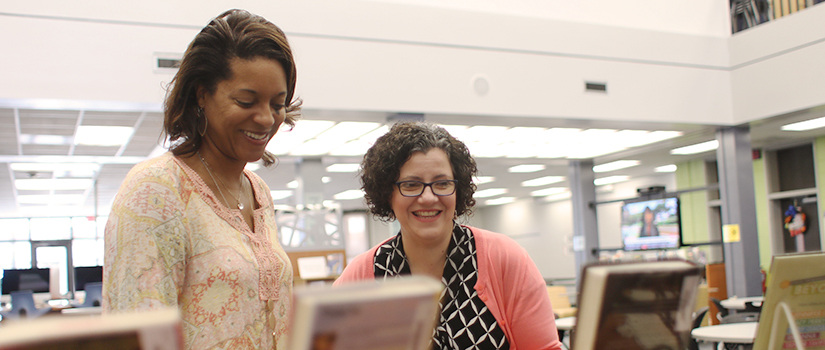Posted September 30, 2019. Updated October 1, 2019
By Rebekah Friedman, communications manager, rebekahb@mailbox.sc.edu, 803-576-7270
Photo: Lucy Santos Green (right) meets with Richland Northeast High School librarian
Pamela Williams, president of the South Carolina Association of School Librarians
and a 2004 MLIS alumna. Green’s study will help school librarians like Williams evaluate
their co-teaching efforts.
Ask Lucy Santos Green to explain Guided Inquiry Design and she’ll tell you about rollercoaster engineers and toy cars.
Three years ago, Green — now an associate professor in the School of Library and Information Science — co-taught a unit on force and motion to a class of teachers-in-training. Instead of assigning textbook chapters or drawing diagrams on the board, she brought in a rollercoaster engineer. The students made models with toy cars and tracks. And they even created videos to illustrate what they’d learned.
“They were able to come out of that unit with a strong understanding of what force and motion are and how those concepts are used by an engineer when designing a rollercoaster,” Green says.
GID units like these — inquiry-based collaborations between school librarians and classroom teachers — have gained momentum in K-12 education. But what type of time and support do teachers need? And how critical are librarians to their success?
The Institute of Museum and Library Services has awarded Green a $376,000 grant to explore these questions. Her findings could boost support for librarians to work side-by-side with classroom teachers and potentially prevent school librarian jobs from being cut.
What is Guided Inquiry Design?
The GID model brings together librarians, teachers and even local professionals to
design and implement educational units as a team. The inclusion of outside experts
underscores how concepts like force and motion can translate into day-to-day life.
“More than ever, our students need to understand that what they’re doing in the classroom has real-world application,” Green says.
Students review a broad range of information sources on the topic to formulate research questions that pique their interest, a technique intended to promote a better understanding of the subject matter. That doesn’t mean they can skip over the hard parts. GID-trained educators provide enough structure throughout the unit to keep participants on track, and they set rigorous criteria for the final projects. Participants come away more engaged and better prepared to think critically beyond the classroom.
“It’s not just about delivering content to your students and having them regurgitate it like a computer,” Green says. “It’s about helping them navigate the information landscape and come to strong conclusions.”
Proving the value of librarians
From bolstering research skills to promoting digital literacy, the scope of what modern
librarians do has seen a rapid expansion since the rise of the internet.
Yet between 2009 and 2016, about 15 percent of the nation’s full-time school librarian positions were eliminated, according to the National Center for Education Statistics.
Previous studies have suggested that school librarians have a powerful impact on student success rates, but Green hopes hers — which will span up to 6,000 students over three years — will be exhaustive enough to prove it.
“The existing data isn’t always used by systems when evaluating their librarians and allocating resources,” she says. “We need to continue collecting hard data to advocate for our profession.”
Research team members are GID co-creator Leslie Maniotes, associate professor Melissa Johnston from the University of West Georgia and assistant professor Ismahan Arslan-Ari from South Carolina’s College of Education.
Teachers from 60 schools comprising a diverse range of ages, geographical areas and socioeconomic classes will independently teach units in a traditional way for the study’s control data. Then, a GID-trained librarian and classroom teacher will lead the same unit to a different group within the same school. Both groups will be scored on their mastery of the content. Green will also observe instruction and gather feedback from focus groups.
Once completed, the study’s data will be made publicly accessible, fueling additional research for years to come.
Kristin Fontichiaro, a clinical assistant professor at the University of Michigan School of Information, says the school library community is buzzing with excitement about the questions the project may answer.
“Dr. Green’s research is poised to fill a critical gap in our understanding of how our aspirations — for students to engage in deep and thoughtful research — play out in the real-world constraints of school libraries,” Fontichiaro says. “Her analysis will help reveal how skilled librarians navigate the inquiry learning process with students, where they struggle and where there are opportunity gaps. These insights will help library educators better target instruction for aspiring librarians and open new avenues for future research and inquiry for the profession.”
Investing in what works
If the study affirms that students learn more when teachers team up with librarians,
Green says she and her colleagues at SLIS will discuss what that means for the school’s
curriculum.
“Then it becomes a question of how do we make sure our students graduate with the capacity to engage in this work,” she says.
SLIS might put a bigger emphasis on inquiry models or make GID part of the required practicum. The school could even offer professional development opportunities to train working librarians and teachers on using it.
“It’s important that we not only make sweeping declarations about the school library being the heart of the school, but that we take time to investigate our own practice to see the specific decisions we’re making that most benefit our students and are most worthy of our time,” Green says.
